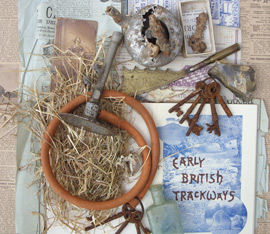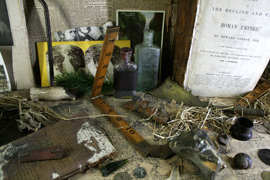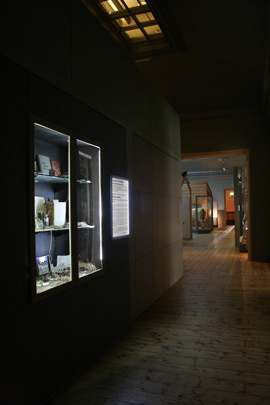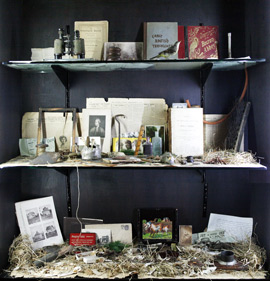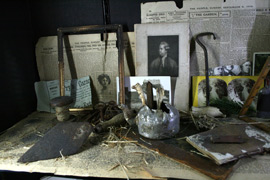Project 10 GOW at GNM
November 1st - 2nd December 2011
Michael Hampton
Old Baxter
“Bones…deadmen’s bones…disjecta membra…hundreds of years rottin’ in the ground… skulls… thighbones come to the surface in Farmer Giles’ turnip field…disjecta membra…the past catching up with us…mors ultima linea rerum est…a bad hand in copperplate…ghost & ghoul…flints in an oak case…ha ha…disjecta membra…reference numbers…Mesolithic…early Iron Age…Romano-British…locals muttering about dark practices…ha ha…that which is hidden shall be found out…disjecta membra…legionaries…criminals…slaves.”
The site of the postmodern museum uniquely allows for the triangulation of literary, ethnographic and purely visual material as a tableau. So the glass vitrine is itself situated inside this larger institutional cabinet, the interactive public museum, which has its methodological antecedents in the European wunderkammern of the 16th and 17th century, such as John Tradescant’s ‘Ark’ and ‘The Bargrave Collection’. Yet in the installation Old Baxter conventional organising principles are largely absent, taxonomic labelling treated as a rueful joke. In effect the viewer is invited into the subconscious of the museum via unofficial deposits; what Hal Foster has called the “anarchive”.
Nominally based on a minor character in M. R. James’s short story ‘A View from A Hill’, the antiquary Baxter is a disturbing figure who features posthumously in the narrative via a set of bizarre remains, e.g. a pair of diabolical customised binoculars. Doubtless he symbolises the grindingly poor yet unencumbered lifestyle James might have wanted himself, though there’s no mistaking the cautionary nature of the tale either, someone out of their depth without the secure epistemological framework a university teaching post gives.
Director of the Fitzwilliam Museum (1886-93), Provost of King’s College Cambridge (1905-1918) and Eton (1918-36), M. R. James by his own admission was not much of a careerist. A medieval manuscript expert prone to “the accumulation of a heap of scraps of odd miscellaneous information”, James often explored the grey area between occultism and reason in his writing, represented in this creepy story, by Baxter and Fanshawe, a Cambridge academic. That Baxter has been practising English juju in connection with his fieldwork, and driven mad or died from shock due to this necromancy is classic Jamesian terrain: the fear of crossing a cosy Edwardian threshold into an adjacent realm of the macabre and spiteful.
Sir Thomas Browne in Hydriotaphia, Urn Burial or a Discourse of the Sepulchral Urns lately found in Norfolk (1658) began to establish the practical and hermeneutic foundations for antiquarianism, or ‘barrow-digging’ as it became known during the Augustan age, but Baxter depsite having published several papers, is not a systematic archaeologist, more a dabbler who dies in mysterious circumstances on Gallows Hill.
Old Baxter is a fanciful rendition of Baxter’s trash, dead man’s effects that prove so unsettling for Fanshawe: a rusty trowel, a school Bunsen burner, a copy of Gibbon’s Decline & Fall of the Roman Empire, a family photo,broken shears, coins etc.
Michael Hampton, August 2011

Stephen Bann, Under the Sign 1994.
Michael Cox, M. R. James; an Informal Portrait 1987.
Hal Foster, ‘An Archival Impulse’ October, Vol. 110, 2004.
BIOGRAPHY
A London based writer and visual artist, who since staging ‘Circumstantial Evidence’ at Fordham Gallery in 1999 (an installation of 100 found objects in self-seal bags) continues to work with abject material. He has previous: a 2006 essay ‘Halloween at the Horniman’
www.slashseconds.org/issues/001/002/articles/mhampton/index.php profiled the ethnographic museum as a container of spookiness, and he contributed to ‘Things’ at the Wellcome Foundation 2011 www.wellcomecollection.org/things. ‘Sylloge’ will appear in the forthcoming publication Magic Power Presence curated by IRIS, 2011, and ‘Platinum Prints’, a sequence of poems generated by a cache of Victorian folkloric photos is due to feature in Rattle Journal #3.
